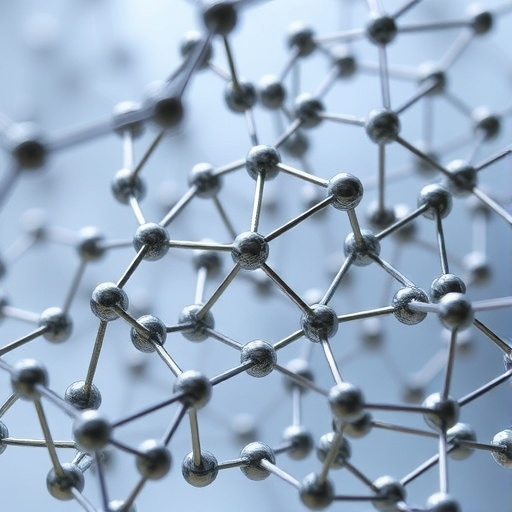In the relentless quest for novel materials, scientists have often confronted a formidable challenge: the sheer combinatorial complexity of chemical elements and their possible alloys. Metallic glasses, a class of materials known for their unique hybrid properties—combining the strength typical of metals with the malleability of plastics—have captivated researchers for decades. Yet, the traditional approach to discovering these materials has long depended on laborious trial-and-error experiments, making the progress slow and expensive. A groundbreaking investigation led by Dr. Yuan-Chao Hu at the Songshan Lake Materials Laboratory offers a transformative solution, leveraging the concept of complex networks to chart the uncharted territory of metallic glass development more efficiently and insightfully.
This pioneering work, recently published in National Science Review, introduces the innovative concept of ‘material networks’ tailored to metallic glasses. Within these networks, individual chemical elements are represented as nodes—akin to people within a social network—while the links between these nodes signify confirmed alloy combinations that have successfully yielded metallic glasses. This analogy illuminates the hidden ‘social’ dynamics among elements, revealing intricate patterns of connectivity that had previously remained obscure within the conventional chemical literature.
By interrogating the architecture of these material networks, Hu and colleagues illuminate a phenomenon analogous to social cliques. Fully connected clusters, or ‘cliques’ of elements where each is linked directly to every other in the group, emerge as critical predictors of stable, multi-component metallic glasses. These cliques serve as a powerful heuristic, enabling researchers to drastically narrow the immense search space—a combinatorial explosion otherwise overwhelming in its complexity—to promising combinations that are chemically predisposed towards glass formation. This approach effectively filters out less viable candidates, optimizing resource allocation in experimental pursuits.
Strikingly, the research team constructed what they term a ‘dynamic network’ that evolves by integrating the chronology of past metallic glass discoveries. Through this temporal lens, they observed that many novel alloys unveiled in recent decades were, in fact, implicitly encoded within the earlier structural patterns of the network. This finding suggests that the conventional research trajectory, often guided by intuition and incremental knowledge building, risks falling into a feedback loop—an ‘innovation trap’—where new discoveries are more so rediscoveries of latent combinations previously unveiled indirectly through network configurations.
Dr. Hu elucidates this conundrum: traditional exploratory methods may inadvertently reinforce known paths, confirming pre-existing knowledge embedded within the network rather than catalyzing fundamentally new alloy systems. The network’s embedded information, if unlocked, can function as a map guiding researchers towards currently uncharted yet promising multi-element combinations that have not yet been experimentally validated.
The network’s growth pattern further defies conventional expectations. Unlike widely studied scale-free networks such as the internet, which display hubs with disproportionately high connectivity, the metallic glass material network exhibits an “abnormally scale-free” character. This unique scaling behavior arises from inherent physical constraints—namely, the finite number of elemental building blocks compared to an exponentially increasing number of possible alloy combinations. The network grows not merely by preferential attachment but also under tight physical and chemical rules, which restrict feasible connections and alloy formations.
This subtle but crucial difference impacts the dynamics of material discovery. It points towards a structured yet expanding combinatorial space constrained by thermodynamics and atomic affinity, providing a mathematically and physically meaningful framework that can predict promising alloy candidates. The material network concept thus embodies a powerful fusion of data-driven analysis with fundamental material science.
What sets this work apart is the methodological rigor. The researchers employed advanced data mining and statistical analyses of an extensive, curated database of known alloys. This quantitative approach transcends traditional expert intuition, harnessing the power of network theory to distill complex relationships into actionable knowledge. By doing so, the study bridges a conceptual gap between materials informatics and classical metallurgy, pioneering a new paradigm for accelerated material innovation.
Such insights have profound implications beyond metallic glasses alone. The underlying principle—that hidden relational structures among fundamental components can prefigure emergent properties—may well be extrapolated to other multi-component systems, including high-entropy alloys and complex functional materials. It ushers in an era where predictive analytics and network science underpin strategy rather than mere serendipity or incremental experimentation.
By systematically exploiting the ‘clique’ structures and network dynamics, scientists can prioritize alloy combinations with a higher likelihood of success, minimize redundant trials, and allocate experimental efforts more judiciously. This strategy promises to expedite the pace of materials discovery, lower associated costs, and accelerate the deployment of advanced materials into technology sectors ranging from aerospace to electronics.
Ultimately, this research invites a profound reevaluation of how scientific exploration unfolds. It underscores that the universe of elemental combinations is not an untamed wilderness but an interconnected landscape governed by discernible patterns. Through the lens of complex networks, these patterns become legible and actionable, guiding researchers towards breakthroughs that were previously hidden beneath layers of complexity.
This network-driven paradigm for material discovery exemplifies the fertile synergy between data science, statistical physics, and materials engineering. As the volume of available chemical and alloy data continues to burgeon, such integrative approaches will be indispensable for unlocking next-generation materials that meet the growing demands of human society and technological advancement.
The study by Dr. Yuan-Chao Hu and his team signals a watershed moment in the field, providing not only a conceptual framework but also practical tools for accelerating the discovery of metallic glasses. In doing so, it promises to transform metals research and catalyze innovations that could redefine material capabilities in the 21st century.
Subject of Research: Development and discovery of metallic glasses through material network analysis.
Article Title: The Material Network of Metallic Glasses: Predicting Novel Alloys from Hidden Element Relationships.
Web References: http://dx.doi.org/10.1093/nsr/nwaf398
References: Published in National Science Review.
Image Credits: ©Science China Press
Keywords: Metallic Glasses, Material Networks, Alloy Discovery, Complex Networks, Data-Driven Materials Science, Metallic Glass Cliques, Innovation Trap, Scale-Free Network, Materials Informatics, Multi-Component Alloys, Network Dynamics, Statistical Analysis




